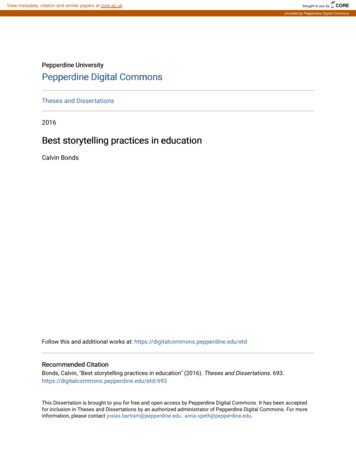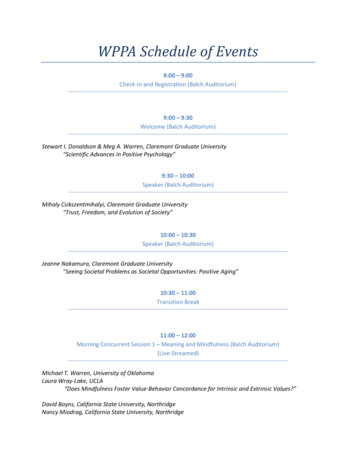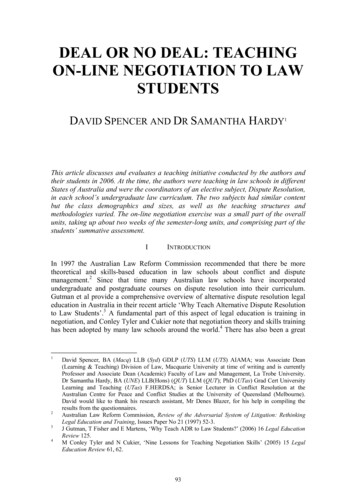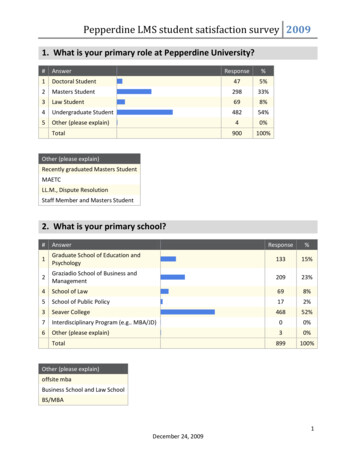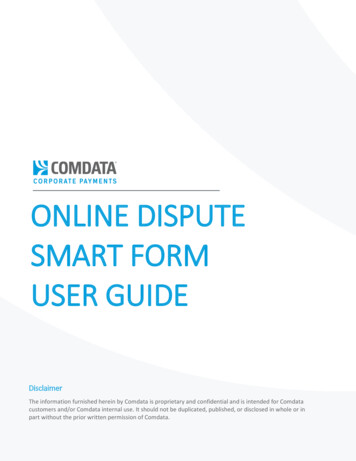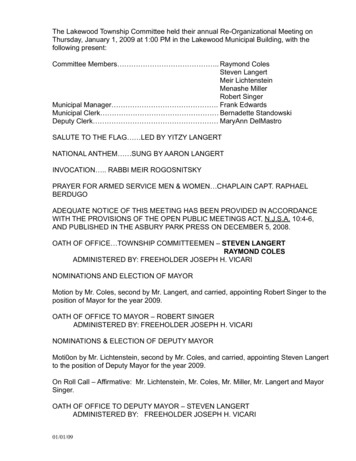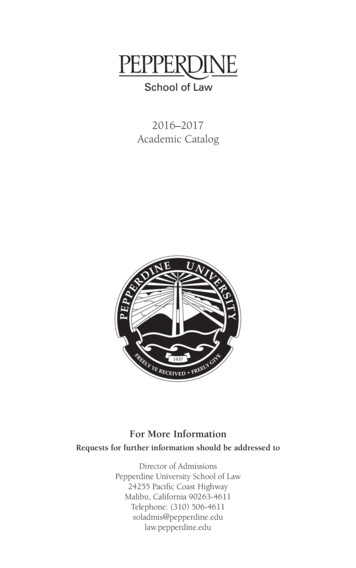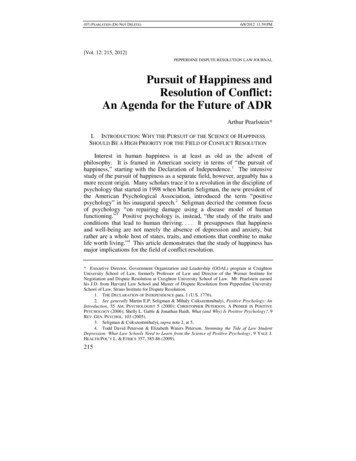
Transcription
(07) P EARLSTEIN (DO NOT DELETE)6/8/2012 11:59 PM[Vol. 12: 215, 2012]PEPPERDINE DISPUTE RESOLUTION LAW JOURNALPursuit of Happiness andResolution of Conflict:An Agenda for the Future of ADRArthur Pearlstein*I. INTRODUCTION: WHY THE PURSUIT OF THE SCIENCE OF HAPPINESSSHOULD BE A HIGH PRIORITY FOR THE FIELD OF CONFLICT RESOLUTIONInterest in human happiness is at least as old as the advent ofphilosophy. It is framed in American society in terms of “the pursuit ofhappiness,” starting with the Declaration of Independence. 1 The intensivestudy of the pursuit of happiness as a separate field, however, arguably has amore recent origin. Many scholars trace it to a revolution in the discipline ofpsychology that started in 1998 when Martin Seligman, the new president ofthe American Psychological Association, introduced the term “positivepsychology” in his inaugural speech.2 Seligman decried the common focusof psychology “on repairing damage using a disease model of humanfunctioning.”3 Positive psychology is, instead, “the study of the traits andconditions that lead to human thriving. . . . It presupposes that happinessand well-being are not merely the absence of depression and anxiety, butrather are a whole host of states, traits, and emotions that combine to makelife worth living.”4 This article demonstrates that the study of happiness hasmajor implications for the field of conflict resolution.* Executive Director, Government Organization and Leadership (GOAL) program at CreightonUniversity School of Law, formerly Professor of Law and Director of the Werner Institute forNegotiation and Dispute Resolution at Creighton University School of Law. Mr. Pearlstein earnedhis J.D. from Harvard Law School and Master of Dispute Resolution from Pepperdine UniversitySchool of Law, Straus Institute for Dispute Resolution.1. THE DECLARATION OF INDEPENDENCE para. 1 (U.S. 1776).2. See generally Martin E.P. Seligman & Mihaly Csikszentmihalyi, Positive Psychology: AnIntroduction, 55 AM. PSYCHOLOGIST 5 (2000); CHRISTOPHER PETERSON, A PRIMER IN POSITIVEPSYCHOLOGY (2006); Shelly L. Gable & Jonathan Haidt, What (and Why) Is Positive Psychology?, 9REV. GEN. PSYCHOL. 103 (2005).3. Seligman & Csikszentmihalyi, supra note 2, at 5.4. Todd David Peterson & Elizabeth Waters Peterson, Stemming the Tide of Law StudentDepression: What Law Schools Need to Learn from the Science of Positive Psychology, 9 YALE J.HEALTH POL’ Y L. & ETHICS 357, 385-86 (2009).215
(07) P EARLSTEIN (DO NOT DELETE)6/8/2012 11:59 PMThough emerging from the field of psychology, the growing study ofhappiness has reached across disciplines and methodologies. 5 In academia,those involved in happiness studies emphasize that their approach isscientific and systematic. 6 Christopher Peterson, a pioneer in positivepsychology, explains that the approach assumes “that human goodness andexcellence are as authentic as disease, disorder, and distress.”7 Positivepsychology relies, he reminds us, “on empirical research to understandpeople and their lives.” 8 Indeed, there is an enormous body of research onhappiness with daily advances from a variety of scholarly perspectives. 9 Inaddition to psychology, disciplines involved in the systematic pursuit ofresearch findings include economics, public policy, biology, neuroscience,philosophy, history, education, medicine, and many others.10 The WorldDatabase of Happiness maintains a “Continuous Register of ScientificResearch on Subjective Appreciation of Life,” which, as of late March 2012,had cataloged “6896 publications on . . . happiness, of which 3408 reportempirical investigations using accepted measures of happiness.” 11 Amongthese were “748 measures of happiness used in 1440 studies[;] 4335distributional findings in the general public in 159 nations[;] 14327correlational findings observed in 1437 studies excerpted from 1087publications,” not to mention almost twice as many “findings waiting to beentered.”12In addition to more scientifically oriented work on happiness, interest inthe field has sparked an explosion in the number of popular psychology andself-help books, magazine articles, and stories elsewhere in the mediafocusing on happiness. 13 Moreover, the development of corporate andinstitutional training and consultation on happiness has continued unabatedfor some time.14 This has led to what one commentator, noting the degree to5. See PETERSON, supra note 2, at 10.6. Id.7. Id. at 5.8. Christopher Peterson, Positive Social Science, 591 ANNALS AM . ACAD. POL. & SOC. SCI.186, 187-88 (2004).9. PETERSON, supra note 2, at 9.10. See generally PETERSON, supra note 2.11. Ruut Veenhoven, World Database of Happiness: Continuous Register of ScientificResearch on Subjective Appreciation of Life, ERASMUS UNIVERSITY ROTTERDAM ,http://worlddatabaseofhappiness.eur.nl (last visited Mar. 27, 2012).12. Id.; see, e.g., Bruno S. Frey & Alois Stutzer, What Can Economists Learn from HappinessResearch?, 40 J. ECON. LITERATURE 402 (2002) (for an overview of happiness studies in the field ofeconomics).13. E.g., Jeffrey Zaslow, Happiness, Inc., WALL ST. J., Mar. 18, 2006, at P1.14. Id.216
(07) P EARLSTEIN (DO NOT DELETE)6/8/2012 11:59 PM[Vol. 12: 215, 2012]PEPPERDINE DISPUTE RESOLUTION LAW JOURNALwhich “companies are putting the findings [of happiness research] to work,”referred to as “a sort of happiness-industrial complex.” 15In even a cursory review of major books and articles on the positivepsychology movement and the burgeoning field of happiness science, thosewho study or practice conflict analysis and resolution will discover a greatdeal of familiar territory.The new packaging of approaches andperspectives, derived from age-old sets of principles and practices—such asnegotiation, mediation, and arbitration—as Alternative Dispute Resolution(ADR) or “conflict resolution” in the late 1970s, may be seen ascorresponding to a similar repackaging of happiness, well-being, and pursuitof the good life as “positive psychology” in the late 1990s.16 Therelationship between positions and interests emphasized in conflictresolution17 greatly mirrors the relationship between pleasure andmeaningfulness examined in the study of happiness 18—in both cases, thefocus is on what lies beneath surface expressions of preference. Thedifficulty human beings have in predicting their own future reactions to theoutcomes of present decisions (framed as “psychological impediments” toresolving conflict, on the one hand, or to finding happiness on the other) iscompelling in both worlds of study. The web of disciplines and findingsembodied in both happiness studies and conflict resolution studies aresubstantially similar in many ways; where they are not the same, they arealmost always complementary. 19In the application of happiness studies, as in that of conflict resolutionstudies, there is a strong focus on constructive goals and quality of life inrelational settings.20 Though the terminology often differs, both areas tendto place emphasis on exploring underlying interests in achieving superiorresults.21 This article examines the modern study of happiness in Part I as abasis for comparison and application to the field of conflict resolution inlater sections.15. Id.16. TAL BEN-SHAHAR, H APPIER: LEARN THE SECRETS TO DAILY J OY AND LASTINGFULFILLMENT 127-28 (2007).17. OLIVER RAMSBOTHAM, TOM WOODHOUSE & HUGH MIALL, CONTEMPORARY CONFLICTRESOLUTION 21 (3d ed. 2011).18. See, e.g., Morten L. Kringelbach & Kent C. Berridge, The Functional Neuroanatomy ofPleasure and Happiness, 9 DISCOVERY MED. 579 (2010).19. Neil Thin, SOCIAL HAPPINESS: THEORY INTO POLICY AND PRACTICE 240 (2012).20. MICHAEL ARGYLE, THE PSYCHOLOGY OF H APPINESS 71 (2nd ed. 2001).21. Id.217
(07) P EARLSTEIN (DO NOT DELETE)6/8/2012 11:59 PMA compelling argument supports applying the findings of happinessstudies to the field of conflict resolution; this may be understood in thecontext of two assumptions at the outset: (1) Unhappy people are morelikely to find themselves in unproductive or even destructive conflict thanhappy people (and conversely for happy people); and (2) People who findthemselves in unproductive or destructive conflict are more likely thanothers to become unhappy.While proof is beyond the scope of this article, and there is a surprisingdearth of research into the connection between happiness and humanconflict, there is at least some evidence of the truth of these statements inresearch findings.22 “Those who identify themselves as happy in surveys,”for example, are less likely “to get involved in disputes at work.” 23 There isalso research showing that happy people who marry are more likely toexperience “marital well-being” and less likely to get divorced than unhappypeople.24 At the same time, a number of surveys and studies reveal adisproportionate amount of unhappiness within the legal profession. 25Strong signs indicate that the “adversarial mindset amongst lawyers”contributes to their dissatisfaction. 26 This article explores the existing, ifslim, body of evidence supporting the hypothesized connection betweenhappiness and conflict in Part II. This article also discusses a corollarybetween the two initial basic hypotheses, namely that there is a feedbackloop between unhappiness and lack of cooperation as well as betweenhappiness and cooperation. Unhappiness leads to conflict, which leads tounhappiness, and so on. Likewise, happiness leads to cooperation (or lessconflict), which leads to happiness.There is a remarkable similarity in the interventions being developedand prescribed in the fields of “conflict interventions” and “happinessinterventions.” From the importance of forgiveness and social connections,to the use of appreciative inquiry, interventions tailored to the advancementof happiness are often nearly identical to key interventions in conflict. Thelarge degree to which happiness interventions and conflict interventions22. See generally Robert H. Frank, Should Public Policy Respond to Positional Externalities?,92 J. PUB. ECON. 1777 (2008).23. Id. at 1779.24. Sonja Lyubomirsky, Laura King & Ed Diener, The Benefits of Frequent Positive Affect:Does Happiness Lead to Success?, 131 PSYCHOL. BULL. 803, 832 (2005).25. Nancy Levit & Douglas O. Linder, Happy Law Students, Happy Lawyers, 58 SYRACUSE L.REV. 351, 351-52 (2008).26. Krista Riddick Rogers, Comment, Promoting a Paradigm of Collaboration in anAdversarial Legal System: An Integrated Problem Solving Perspective for Shifting PrevailingAttitudes from Competition to Cooperation Within the Legal Profession, 6 BARRY L. REV. 137, 138(2006).218
(07) P EARLSTEIN (DO NOT DELETE)6/8/2012 11:59 PM[Vol. 12: 215, 2012]PEPPERDINE DISPUTE RESOLUTION LAW JOURNALoverlap is unlikely to be coincidental. Much of this replication may belinked to the high placement of happiness on the hierarchy of humaninterests—conflict resolution ultimately focuses to a large degree on meetingneeds and interests in the most profound way. 27 Part III addresses theapparent convergence between interventions for happiness and conflict, andsuggests this convergence is a further demonstration of the link betweenconflict and happiness.Central to the similarities in the studies of conflict and happiness is theelement of interest. 28 Part IV examines whether happiness is, in effect, theultimate human interest. In looking at the implications of an affirmativeanswer, this article also shows how lessons from happiness studies apply tothe value of a dispute settlement and to the methods for handling conflictwithin organizations. Alternatively, this article explores whether theemphasis on happiness, like the emphasis on resolution of conflict, can betaken too far and lead, for example, to injustice.In the Conclusion, this article consolidates and underscores theimplications for the field of conflict resolution. Additionally, this articleconsiders an agenda and major issues for future research and looks at somepolicy implications for ADR, implicit in what I refer to as the potential forcapitalizing on happiness. By accumulating “happiness capital,” this articleargues that we can develop and leverage a major asset for the more effectiveengagement and resolution of conflict.II. THE STUDY AND SCIENCE OF HAPPINESSA. Positive PsychologyPositive psychology is the term most closely associated with the modernstudy of happiness.29 As noted above, the term was coined by Seligman in1998 and refers to placing a greater emphasis on our well-being as opposedto our deficits.30 It is tied to “human goodness and excellence” rather thanmental illness or disease.31 The field of positive psychology has been27.28.29.30.31.219Gable & Haidt, supra note 2, at 104.See generally BEN-SHARAR, supra note 16.See generally Seligman & Csikszentmihalyi, supra note 2.Id.PETERSON, supra note 2, at 11.
(07) P EARLSTEIN (DO NOT DELETE)6/8/2012 11:59 PMassociated with humanistic traditions in general and has been significantlyinfluenced by humanistic psychology.32 Unlike humanistic psychology,which shied away from quantitative research and more broadlyacknowledged the limitations of the experimental method, positivepsychology has involved a heavy focus on quantitative, experimentalresearch.33 It has sought standing in the scientific community through theuse of the latest tools and techniques in science and has successfullyestablished itself on par with other, more science-oriented branches ofpsychology.34 A recent historical analysis argues that “[t]he reputation ofpositive psychology may match the popularity of contemporary cognitivepsychology closely associated with cognitive neuroscience and computerscience.”35 Arguably, then, the science of happiness is largely based onempirical research using validated measures, the relative lack of which isdetrimental to the reputation and effectiveness of the field of conflictresolution.36B. Defining HappinessThe word happiness is used to describe many different things, and insome ways it is an elusive term. Etymologically, it is from the same root—hap—as the word “happen.”37 Basically, hap refers to luck—that whichhappens—and came to be associated with good luck. 38 There is no doubtthat happiness is something highly valued for ourselves and for those wecare about. Many terms are often equated with happiness. “Words likepleasure, bliss, ecstasy, and contentment are often used interchangeably withthe word happiness but . . . [t]hese emotions are fleeting, and while they areenjoyable and significant, they are not the measure—or the pillars—ofhappiness.”3932. Erik E. Noftle, Sarah A. Schnitker & Richard W. Robins, Character and Personality:Connections Between Positive Psychology and Personality Psychology, in DESIGNING POSITIVEPSYCHOLOGY: TAKING STOCK AND MOVING FORWARD 207, 208 (Kennon M. Sheldon, Todd B.Kashdan & Michael F. Steger eds., 2011).33. Veenhoven, supra note 11.34. Id.35. ERIC SHIRAEV, A H ISTORY OF PSYCHOLOGY: A GLOBAL PERSPECTIVE 450 (2011).36. Id.37. Gloria Vivenza, Happiness, Wealth and Utility in Ancient Thought, in HANDBOOK ON THEECONOMICS OF HAPPINESS 3, 15 (Luigino Bruni & Pier Luigi Porta eds., 2007).38. Id.39. BEN-SHAHAR, supra note 16, at 6. It is worth noting that Ben-Shahar’s course onhappiness at Harvard University is the most popular course in that university’s history, withenrollment at one time reaching over 800 students. Id. at vii-viii.220
(07) P EARLSTEIN (DO NOT DELETE)6/8/2012 11:59 PM[Vol. 12: 215, 2012]PEPPERDINE DISPUTE RESOLUTION LAW JOURNALIn a systematic sense, it is clear that when we are talking abouthappiness, we generally are not talking about sensations of pleasure andcomfort—hedonism—alone. The modern philosopher Robert Nozickfamously demonstrates, by taking us through a thought experiment, thatpleasure alone is not the essence of happiness. 40 Suppose technologyadvances to the point where virtual reality machines allow you to feel anyexperience that you wish; that these machines also cause you to forget thatyou are hooked up so you feel the experience and the sensation of happinessand have no reason to believe it is not genuine. 41 If offered the chance to be“hooked up” for the rest of your life, would you accept?42 Nozick arguesthat people generally would reject such an offer because the happinessprovided by the “experience machines” would not be real.43 Lacking aconnection with activity would remove what really matters—the doing.44Nozick concludes that, regardless of how a person feels when hooked up tothe machine, because the emotion is based on “egregiously unjustified andfalse evaluations,” we would not term such a person “happy.”45Seligman emphasizes the notion of what he calls “authentichappiness.”46 The “pleasant life” involves the net surplus of positive overnegative emotions associated with hedonism, and “the good life” is obtainedby getting what we desire—which may include, but is not limited to, purepleasure.47 These two variants are combined with the “meaningful life”—participating in something larger than ourselves through valuable activity—to produce a full life in which happiness is “authentic.”48 Seligman’sconcept is essentially in line with an ancient Greek term for happiness,eudaimonia, which captured a sense of flourishing and a life well-lived.4940.41.42.43.44.45.ROBERT NOZICK, THE EXAMINED LIFE: PHILOSOPHICAL MEDITATIONS 104 (1989).Id.Id. at 105.Id. at 106.Id. at 107.Id. at 111. The concept of the “experience machine” was originally advanced by Nozickin ROBERT N OZICK, ANARCHY, STATE, AND UTOPIA (1974).46. See generally MARTIN E.P. SELIGMAN, AUTHENTIC HAPPINESS: USING THE NEW POSITIVEPSYCHOLOGY TO REALIZE YOUR POTENTIAL FOR LASTING FULFILLMENT (2002).47. Id. at 249.48. Id.49. DANIEL G ILBERT, STUMBLING ON H APPINESS 36 (2006).221
(07) P EARLSTEIN (DO NOT DELETE)6/8/2012 11:59 PMFor Socrates, Plato, Aristotle, Cicero, and even Epicurus . . . the only thing that couldinduce that kind of happiness was the virtuous performance of one’s duties, with the50precise meaning of virtuous left for each philosopher to work out for himself.More recently, Seligman himself has moved from focusing on“authentic happiness” to focusing on the “well-being theory” which, inaddition to the aspects of happiness—positive emotion, engagement, andmeaning—that lead to life satisfaction measured subjectively, adds elementsinvolving relationships and achievements; well-being is measured in termsof “flourishing.”51While there is no single definition of happiness, much of the researchthat has been done in recent years focuses on happiness as a measure of“subjective well-being” (SWB).52 Essentially, it involves asking people howthey like their lives, and often involves some version of the question: “Allthings considered, how satisfied are you with your life as a whole thesedays” or “[t]aken all together, how would you say things are these days?”53Unless otherwise indicated, the term “happiness” is intended to besynonymous with SWB, while remaining mindful of other definitions andparticularly the importance of meaningfulness and reflection in “authentic”happiness.C. The Conduct of Happiness ResearchOver the last two decades, efforts to engage in a scientific approach tohappiness have involved various measurements of SWB.54 Many of thestudies have taken measurements through simple “surveys that ask people toreport how happy they are.”55 As previously mentioned, survey questionsgenerally ask a person how satisfied they are with their life “as a whole.”56A more rigorous survey approach involves sampling how people are viewingtheir experiences in real time. 57 With this method, participants are typicallygiven a beeper or receive text messages so that they can be asked, withoutwarning, to answer questions about how they feel right at that moment, whatthey were doing at the time, and how strongly they feel, whether positive or50. Id.51. MARTIN E.P. SELIGMAN, FLOURISH: A VISIONARY NEW UNDERSTANDING OF HAPPINESSAND WELL-BEING 26 (2011) .52. Daniel Kahneman & Alan B. Krueger, Developments in the Measurement of SubjectiveWell-Being, 20 J. ECON. PERSP., no. 1, 2006 at 3.53. Id. at 6.54. Frank, supra note 22, at 1779.55. Id.56. Kahneman & Krueger, supra note 52, at 6.57. Id.222
(07) P EARLSTEIN (DO NOT DELETE)6/8/2012 11:59 PM[Vol. 12: 215, 2012]PEPPERDINE DISPUTE RESOLUTION LAW JOURNALnegative.58 In a variation on this approach, participants respond to aquestionnaire that has them recall their activities from one day before—theyare called upon to essentially construct a short diary of the previous day inwhich they systematically describe “episodes” in the day and then rate theexperiences according to specified criteria.59Interestingly, these various approaches to self-reported levels ofhappiness show meaningful correlations with a variety of measurements,including reports by friends, roommates, and spouses; 60 observations offacial expressions61 and results of electromyography (which measures thefrequency of smiling); “sophisticated electroencephalographic assays thatmeasure the frequency and amplitude of the electrical waves emanating fromdifferent sites in the brain;”62 and a range of other physiological phenomena.“In brief, the happiness literature has identified measures of humansubjective well-being that are consistent, valid, and reliable.”63D. Major Correlations with HappinessHappiness, as measured in a variety of ways, tends to be highlycorrelated with a number of observable human behaviors and characteristics.One of the strongest sets of correlations is with a range of social ties. Ingeneral, “being alone appears to be worse for SWB than being part of apartnership,”64 such as a marriage. A number of studies have demonstrated alink between happiness and socializing with family members, close friends,58. Mihaly Csikszentmihalyi & Jeremy Hunter, Happiness in Everyday Life: The Uses ofExperience Sampling, 4 J. HAPPINESS STUD. 185, 186 (2003).59. Daniel Kahneman, Alan B. Krueger, David Schkade, Norbert Schwarz & Arthur A. Stone,A Survey Method for Characterizing Daily Life Experience: The Day Reconstruction Method, 306SCIENCE 1776, 1776 (2004).60. See Sonja Lyubomirsky & Heidi S. Lepper, A Measure of Subjective Happiness:Preliminary Reliability and Construct Validation, 46 SOC. INDICATORS RES. 137, 148 (1999)(people that say they are happy tend to be rated as happy by those that know them).61. LeeAnne Harker & Dacher Keltner, Expressions of Positive Emotion in Women’s CollegeYearbook Pictures and Their Relationship to Personality and Life Outcomes Across Adulthood, 80 J.PERSONALITY & SOC. PSYCHOL. 112, 121 (2001).62. Frank, supra note 22, at 1779.63. Id.64. Paul Dolan, Tessa Peasgood & Mathew White, Do We Really Know What Makes UsHappy? A Review of the Economic Literature on the Factors Associated with Subjective Well-Being,29 J. ECON. PSYCHOL. 94, 106 (2008).223
(07) P EARLSTEIN (DO NOT DELETE)6/8/2012 11:59 PMor neighbors.65 Beyond such links and the “partnerships” associated withmarriage and other intimate relationships, people that get involved inreligious congregations or other volunteer organizations tend to report higherlevels of life satisfaction.66The feeling of being “in control” over one’s life circumstances also hasa strong correlation with happiness. This link has been attributed to the factthat “the brain constantly needs to feel that it is in charge, that everythinghas an explanation, that events are not spiraling out of control.”67 The morewe feel in control, the more satisfied we are likely to be. If there iscausality, it may flow in either direction. In general, “happy people aremore likely to evidence greater self-control and self-regulatory and copingabilities.”68Trust and happiness are also correlated. 69 The more one feels able totrust others, the greater the likelihood of reporting better life satisfaction.70This association applies not only to trust in other individuals, but to trust ingovernment institutions, including the police and the legal systemgenerally.71 “In short, feeling able to trust others—both those among whomone lives and works and those in authority—is strongly associated withhigher subjective well-being.”72Charitable giving—donations of time, money, or other elements—isstrongly linked to reported happiness. 73 “Indeed, this effect is one of themost robust findings in the literature on positive mood and social behavior,having been variously called the ‘feel good, do good’ phenomenon, the‘glow of goodwill,’ and the ‘warm glow of success.’”74 These findings areoutcomes of experimental studies demonstrating a clear connection between65. See, e.g., ROBERT D. PUTNAM , B OWLING ALONE: THE COLLAPSE AND REVIVAL OFAMERICAN COMMUNITY 93-95 (2000); Orsolya Lelkes, Knowing What Is Good for You: EmpiricalAnalysis of Personal Preferences and the “Objective Good”, 35 J. SOCIO-ECON. 285 (2006);Nattavudh Powdthavee, Putting a Price Tag on Friends, Relatives, and Neighbours: Using Surveysof Life Satisfaction to Value Social Relationships, 37 J. SOCIO-ECON. 1459 (2008).66. John F. Helliwell, How’s Life? Combining Individual and National Variables to ExplainSubjective Well-Being, 20 ECON. MODELING 331, 348 (2003).67. EDUARDO PUNSET, THE HAPPINESS TRIP: A SCIENTIFIC JOURNEY 55 (2007).68. Sonja Lyubomirsky, Kennon M. Sheldon & David Schkade, Pursuing Happiness: TheArchitecture of Sustainable Change, 9 REV. GEN. PSYCHOL. 111, 112 (2005).69. John F. Helliwell & Robert D. Putnam, The Social Context of Well-Being, 359 PHIL.TRANSACTIONS ROYAL SOC’ Y LONDON 1435, 1442 (2004).70. Id.71. Id.72. Id.73. Lyubomirsky, King & Diener, supra note 24, at 837.74. Id.224
(07) P EARLSTEIN (DO NOT DELETE)6/8/2012 11:59 PM[Vol. 12: 215, 2012]PEPPERDINE DISPUTE RESOLUTION LAW JOURNALhappy moods and contributing to charity—needy children, donating blood,and similar behaviors. 75There are many other correlations between happiness and varioushuman factors, both characteristics and behaviors. 76 Among these are:education (higher levels correlated with SWB); physical health; employment(being unemployed, not surprisingly, is correlated with being less happy);commuting to work (greater commuting time correlated with lower lifesatisfaction); physical exercise; age (surprisingly, older people tend to reportbeing happier than people in their 30s and 40s); and gender (women tend toreport greater happiness than men). 77The relationship between happiness and income has proven to be morecomplicated.78 Substantial debate on this correlation centers largely on aphenomenon that has come to be known as “the Easterlin Paradox.” 79 A1974 study by Richard Easterlin found that people in wealthier countrieswere not generally happier than people in poorer countries, though there wassome link within individual countries up to a certain level of income. 80Decades later, British economist Richard Layard claimed to havedemonstrated that above little more than a subsistence level (about 15,000),there is minimal correlation between one’s income and one’s happiness,81providing further support for the concept of the Easterlin Paradox. Othershave relied on quite different study data to argue that the Easterlin Paradoxis wrong. Matt Ridley argues against the Easterlin Paradox: “Rich peopleare happier than poor people; rich countries have happier people than poorcountries; and people get happier as they get richer.”82 Ridley further notesthat in “all three categories of comparisons—within countries, betweencountries, and between times—extra income does indeed buy general wellbeing.” 83 Ridley does acknowledge that, despite income growth in the U.S.,“Americans show no trend toward increasing happiness. Is this because the75.76.77.78.Id.Dolan, Peasgood & White, supra note 64, at 98-104.See, e.g., id. (for more details on these factors).Richard Easterlin, Does Economic Growth Improve the Human Lot?, in NATIONS ANDHOUSEHOLDS IN ECONOMIC GROWTH: ESSAYS IN HONOR OF MOSES ABRAMOVITZ 89 (Paul A.David & Melvin W. Reder eds., 1974).79. Id.80. See generally id.81. See RICHARD LAYARD, H APPINESS: LESSONS FROM A NEW SCIENCE 3 (2005).82. MATT RIDLEY, THE RATIONAL OPTIMIST: HOW PROSPERITY EVOLVES 26 (2010).83. Id.225
(07) P EARLSTEIN (DO NOT DELETE)6/8/2012 11:59 PMrich had got richer but ordinary Americans had not prospered much in recentyears?Or because America continually draws in poor (unhappy)immigrants . . . ? Who knows?”84 The last question perhaps most accuratelyreflects the current state of consensus about the link between money andhappiness—we simply do not yet have enough information to draw firmconclusions.The variety of correlations with happiness can have major implicationsfor policy and practice in many endeavors, not the least of which is conflictresolution (fully examined below). It is important to exercise caution,however, because the research suffers from the uncertainty that correlationsdo not necessarily establish causations. Much of the literature suggests thatparticular behaviors or characteristics lead to happiness. It may also bepossible, however, “to show that the alternative causal pathway—that happypeople are likely to acquire favorable life circumstances—is at least partlyresponsible for the associations found in the literature.”85 It is easier toestablish a causal connection when there is a passage of time between thecircumstance and reported well-being—or vice versa. Examining therelationship between social connections and happiness can be particularlyproblematic.86 “Unlike many variables, there is unlikely to be a time delayin the causal pathways between social contact and well-being, whichcomplicates any investigation into the direction of causality.”87 However,“prospective and longitudinal studies show that happiness often precedesand predicts” positive outcomes such as financial success, supportiverelationships, coping, and physical and mental health.88E. The Formula for HappinessIn an influential article published in 2005, Professors Lyumbomirsky,She
(07) PEARLSTEIN (DO NOT DELETE) 6/8/2012 11:59 PM [Vol. 12: 215, 2012] PEPPERDINE DISPUTE RESOLUTION LAW JOURNAL 215 Pursuit of Happiness and . (GOAL) program at Creighton University School of Law, formerly Professor of Law and Director of the Werner Institute for Negotiation and Dispute Resolution at Creighton University School of Law. .

